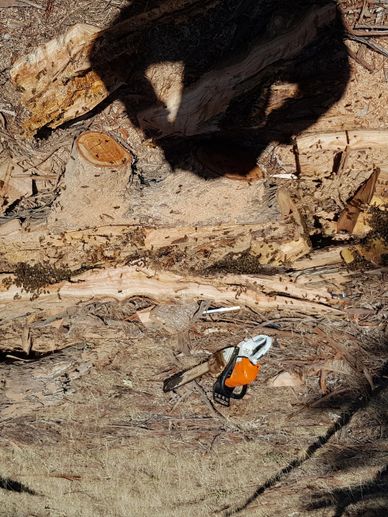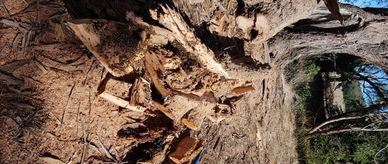0421 885 338
Tree Cutters Escape
The Displaced Home
The Egg Is Cracked Open
The Displaced Home

This beautiful hive was not having a good week. Firstly their home shifted dramatically one night and then someone came along and started to cut it up.
New White Comb
The Egg Is Cracked Open
The Displaced Home

With their hive fallen the bees had to quickly go into comb production so that the comb cells were once again sloping upwards. This resulted in a lot of new white comb in the hive.
The Egg Is Cracked Open
The Egg Is Cracked Open

After several hours of careful work the hive is exposed. When opening a tree hive we don't want to slice through the beehive so it's a slow careful process to not cut too deep.
From Top To Bottom
A Different Perspective

The hive was rather large from being in their location for several years.
Starting At The Bottom
A Different Perspective
A Different Perspective

Now the hard work begins. It's time to cutout the comb in a way that it can be fitted into frames while maintaining the integrity of the hive.
A Different Perspective
A Different Perspective
A Different Perspective

Sometimes it helps to look at the hive from multiple angles so you can make just the right cut.
Cleaning Machines
Cleaning Machines
Cleaning Machines

As we work it's amazing to see how quickly the bees clean up any spilled honey. It doesn't take long for them to take their honey and store it in the new hive.
Pests
Cleaning Machines
Cleaning Machines

The small black beetle in this photo is one of the pests found in beekeeping. The hive beetle can cause major issues to a hive if the hive isn't strong enough to get rid of it. Weak hives will need intervention if this beetle gate crashes the party.
A New Home
Cleaning Machines
Queen Cluster

The comb has now been relocated to the bees new home yet there is too many bees not heading towards the hive entrance. This usually indicates the queen isn't in the new home. Now to ask the bees to lead me to the queen.
Queen Cluster
Queen Cluster
Queen Cluster

By closely watching the bees they will always tell us where the queen can be found. In this case she was hiding in a cluster of bees underneith the hive landing platform. Gently we placed her in the hive.
All Gone
Queen Cluster
All Gone

After several days the bees have accepted their new home and cleaned up the last of any excess honey. Late at night we now close the new hive and relocate it to our quaratine apairy.
Copyright © 2025 Bee Removals Victoria - All Rights Reserved.